Welcome to a new issue of the Journal of Runic Studies, the premier Malkioni publication for studies into the nature of Glorantha. If you haven’t subscribed yet, please consult with the spirit bound to the appropriate electronic page.
This week we had a LOT of posts by Jeff on the Facebook groups, a new Glorantha Initiation Series episode, and that leaves little room for anything else in this issue of the Journal.
God Learner Sorcery
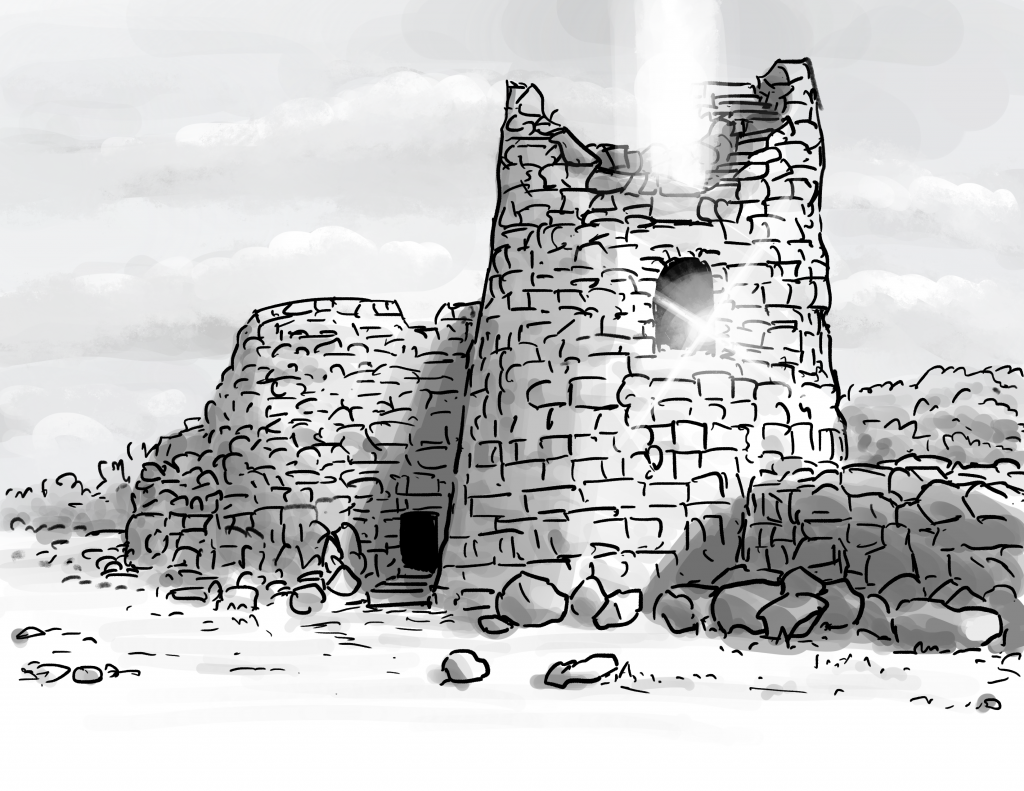
We are now occupying a nice little tower with a long history of previous occupants who have left behind documents, tablets, artifacts, and other kinds of junk. As we clean up and archive these things, we share the most interesting ones with you.
Initiation Series Episode 2

We released the second episode of our “Glorantha newbies” interview series. Our guest Russano Greenstripe talks about bringing Glorantha to D&D, finding inspiration in the Guide, and struggling to convince people to play RuneQuest. Check it out!
A History of the Glowline
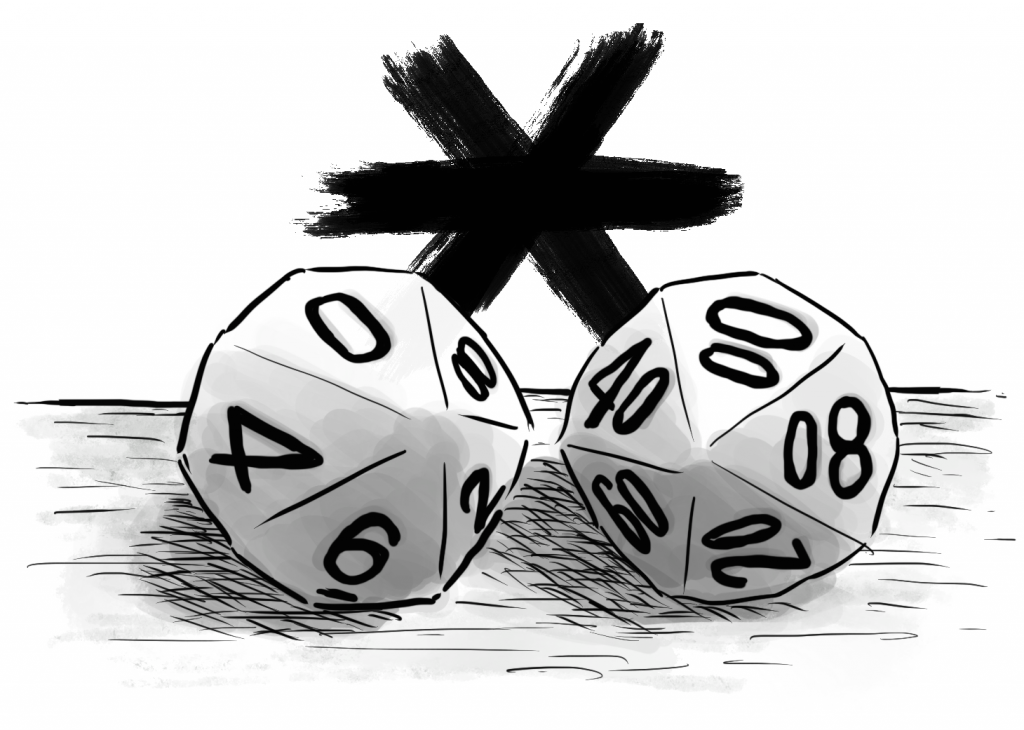
I wrote an article about the history of the Glowline rules in RuneQuest over the editions… Don’t ask me why, I think it was just fun to look through a bunch of books and PDFs. Keep reading into the “Jeff’s Notes” section for Jeff’s in-world take on the Glowline, though!
Chaosium News

Here are this week’s Chaosium news!
New Gamemaster Month 2022
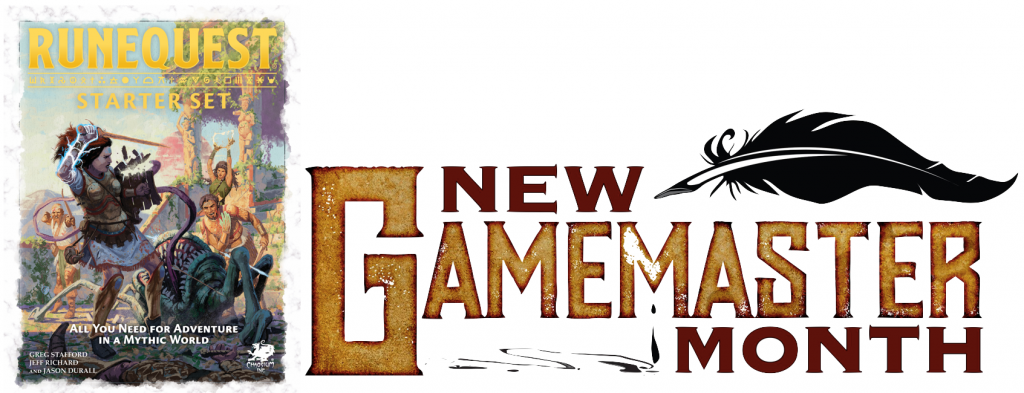
Every January, the people at Monte Cook Games (who publish chunky good stuff like Numenera and Ptolus) organize “New Gamemaster Month“, an initiative focused on helping people make the jump from player to GM (or go straight to GM, too, I guess, that works). They provide several resources for getting started on a few handpicked games, with an active community ready to help on Facebook, Discord, and other places.
For 2022, the game picks include several of my absolute favourites (Delta Green, Unknown Armies, Trail of Cthulhu). As you might have guessed, the selection also includes our good old RuneQuest. You can even get a 10% discount on the core rulebook and/or the starter set to get yourself started…. then, in January, the website will start featuring articles with instructions for preparing and running your first game. So keep an eye on that if you or someone you know wants to start GMing RuneQuest or any of these other fine games.
Jonstown Compendium

The Jonstown Compendium is Chaosium’s community content program for all Gloranthan games, hosted on DriveThruRPG. Disclaimer: all the relevant links are affiliate links that hopefully will let us cover some of the hosting and maintenance costs for the website and podcast! Thanks for using them!
Hsunchen of the East

Paul Baker continues his exploration of Genertela outside of Dragon Pass, with a sourcebook on two eastern Hsunchen tribes: some Yak folk, and some Tiger folk. It includes background and rules for creating characters belonging to these tribes.
Holiday Dorastor: Seven Hills
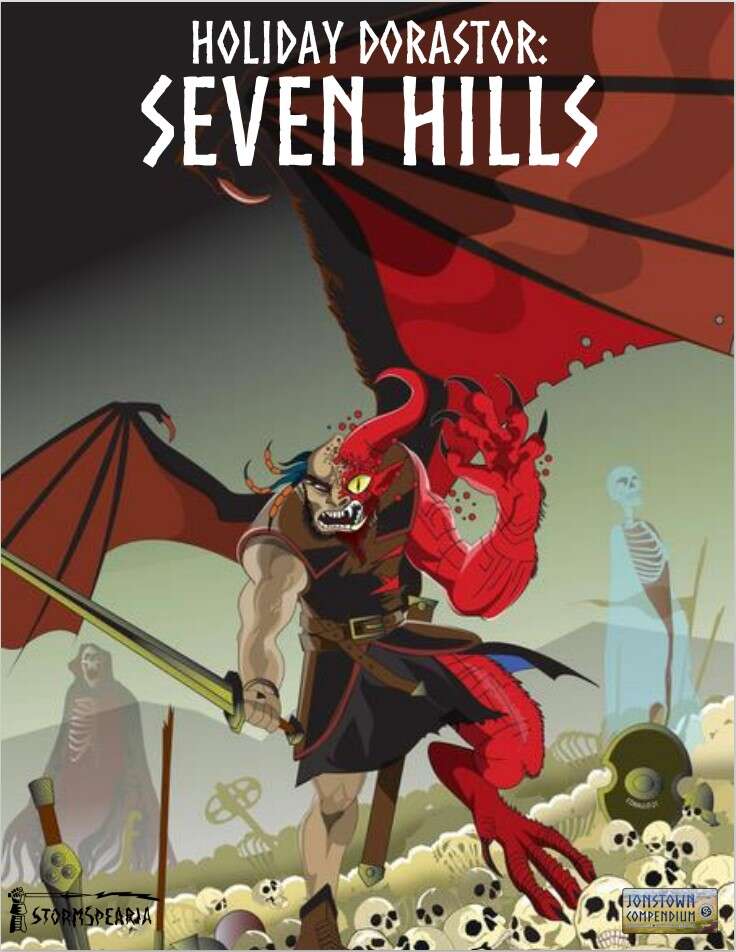
Meanwhile, Stormpearia continues to explore Dorastor (it’s so nice this time of year, isn’t it?) and in particular the area known as the Seven Hills. Expect the usual Stormpearia Dorastor goodness, such as foul creatures, new magic items and spells, and a scenario… or two… or… wait, no, there are eight (8!) scenarios in there! Simon Phipp and Leon Kirshtein promise us that they range from “beginner to advanced”, but I’m not sure I want to see what their idea of “beginner” is…
Holiday Dorastor: Krampuslauf
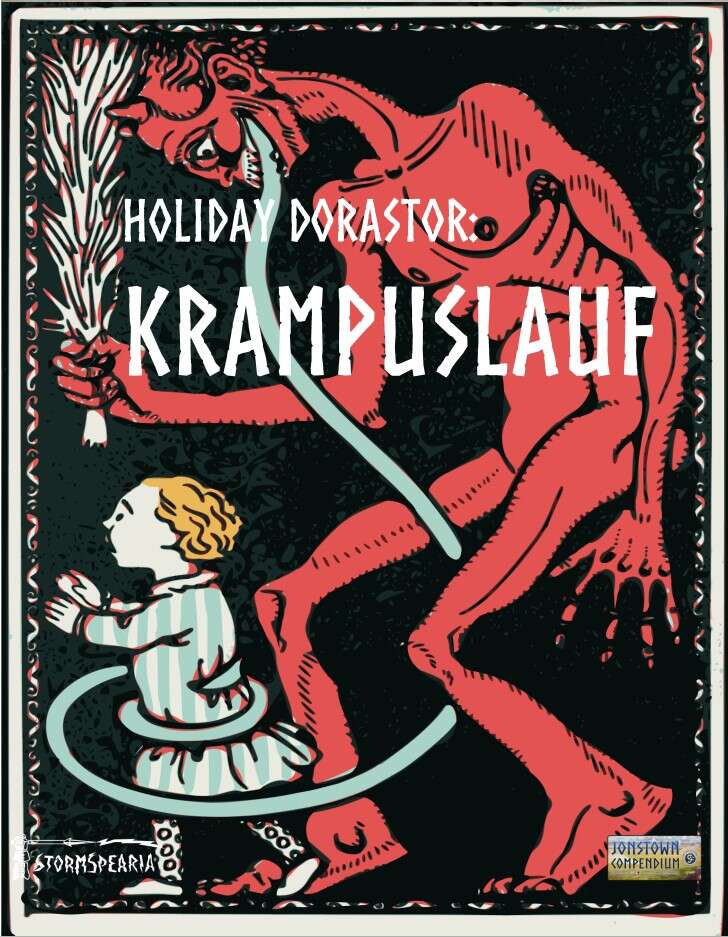
Apparently the previous 130 pages weren’t enough, so Stormpearia also released a much more modest 5 pages supplement to get in the holiday season spirit… have you been naughty or nice? Is Eurmal going to give you candy, or is Krampuslauf going to whip you?
The Company of the Dragon Gets Some Love

No, I don’t mean it that way, you pervert! What I mean is that Andrew Logan Montgomery’s best selling campaign was featured in Geek Native’s “Other Best Selling Fantasy RPGs of 2021“. Congrats Andrew!
Other nice appearances on that list include some Warhammer material, Mythras’ Mythic Babylon sourcebook, and the aforementioned Ptolus monster of a book.
Jeff’s Notes

Jeff Richard, the current mastermind on everything Gloranthan at Chaosium, is often posting notes and thoughts on the RuneQuest Facebook group. Here’s our curated list from the past week. A partial archive of these sources is compiled on the Well of Daliath.
Vasana’s Tattoos
We know that Jeff has been working with artist Anna Orlova to make detailed “turntable” illustrations of several key figures like Argrath and the Feathered Horse Queen (featured in a previous Journal issue). Jeff now shares that they’re also working on detailing exactly what tattoos they have, where, and what they mean. Here’s Vasana:

We can spot Vasana’s initiation tattoos, clan and tribe tattoos, tattoos from other factions like the White Bull, and foci for various spells. Of note, there are also “ordeal tattoos” from particularly big feats such as heroquests or delves down Snakepipe Hollow. Pretty cool! You can glimpse the important events in Vasana’s life this way.
This helps us tremendously with achieving a higher level of artistic consistency – and also lets us gain insight into these characters.
Remember, these tattoos are going to be far more painful than modern tattoos. That pain serves a magical purpose as it allows the recipient to focus on them without seeing them – the pain enhances their magical nature.
The Good Old Times
Jeff talks about the difference between survivors of the God Time, and mortals:
Waertagi, Golden Wheel Dancers, Mistress Race Trolls, elder Giants, Brithini – Glorantha has many relics of the Godtime that exist (to the extent they still do) in defiance of the world of Time. They continue their ancient ways, often refusing to acknowledge or accept Time and its changes. All of these peoples are dying out to a greater or lesser extent. The Golden Wheel Dancers were presumed extinct, at least until 1621.
Mortals, on the other hands, “have proven most successful in Time”. They experience the God Time (through worship and heroquesting and Rune Magic and so on), but as means to affect the mundane world.
Such mortals – in particular, the Orlanthi, the Lunars, and the Malkioni – have played a disproportionate role in the History of Time.
The Orlanthi and Malkioni are not trying to “revive” the good old times of the Storm Age or whatever. They are just tapping into it to be more successful here and now.
They are all good at recognizing the value of an old story or myth at providing guidance for dealing with a different now – but they also can see that the story is not a perfect guide.
[…]
The Orlanthi know that their greatest hero – Harmast Barefoot – assembled the pieces of the Lightbringers Quest from countless stories. And they also know that those stories were not sufficient guidance for him to complete the Lightbringers Quest. He needed to bring in new elements and new experiences to succeed.How do they know that? Because Harmast told them that. Twice.
The Lunars though are a bit more crazy:
They revived a dead goddess and created a Godtime inside of Time. And this Made in Time Godtime is being used at least in part to revive a Golden Age empire. The whole thing is a mad paradox worthy of Illumination points if studied for any length of time!
If you still want another big meta-plot lead (as if we didn’t have enough!), Jeff leaves this for you:
The idea of recreating the Empire of Wyrms Friends might have far more appeal though…..
Human Population in Dragon Pass
Would anyone think about the non-humans? Jeff goes over the early Dawn Age, when “the World Council of Friend (centered on Dragon Pass) united five mortal species, each of roughly equal strength and numbers – humans, trolls […], dragonewts, aldryami, and mostali”. Human population grew a bit faster than the other elder races, but it’s only in the Second Age that they became prominent, mostly because the others “tore themselves apart”.
In the Lunar Heartlands, most humans have likely never seen one of the Elder Races – certainly not the fearsome dragonewts or trolls, and even elves and dwarfs are rarely seen.
Things are different in Dragon Pass and the Holy Country. In the Holy Country, two of the sixths are dominated by Elder Races. Triolini are commonly seen in coastal areas and the trolls still rule their Shadow Plateau and in the Troll Woods.
In Dragon Pass, nonhumans occupied the region without ANY humans prior to about three centuries ago.
That was after the Dragonkill War, in 1120, when several Dream Dragons and True Dragons rose up and killed countless humans out of the blue. Well, not really out of the blue… the humans were threatening Dragonewt cities and nest eggs, I guess. Woops. That’s why you leave the Dragonewts alone now.
This was followed by a couple centuries of the “Inhuman Occupation”, when no humans were seen or dared enter in Dragon Pass. But of course we came back.
Since then, humans have regained their position as the dominant species, but still about a fifth of the population is non-human. Most humans have seen one of the Elder Races, and interaction is frequent. Beastmen, dragonewts, trolls, dwarfs, and elves are commonly seen, certainly along the roads and in the cities, but sometimes even in small villages. Morokanth are seen as often as any other of the Great Tribes, although they are feared (and often despised) as cruel slavers.
The Dragon Pass cultures are thus seen by many in the far West or in the Lunar Heartlands as being essentially non-human in some key regards.
So I guess I should have a lot more non-humans hanging around my markets in Sartar!
The Hill of Orlanth Victorious
Do your Orlanthi adventurers ever go on this pilgrimage?
It is roughly 20 miles from Boldhome to the Hill of Orlanth Victorious – a roughly comparable distance from the Akropolis of Athens to the sanctuary at Eleusis. No trade road connects the two, but countless Sartarites have made the pilgrimage.
During the rule of the Princes of Sartar, the Hill of Orlanth Victorious was where many Sacred Time rites were performed by many tribes and cults, overseen and supported by the Prince, and aided by the Red Vireo. People would travel from Boldhome, Jonstown, or beyond, take lodgings in nearby villages or camp in the fields. Priests and rune lords would offer sacrifices, perform rites and ceremonies, and Orlanth and his Lightbringers would be invoked by all.
The “Red Vireo” is not mentioned in any existing material, but will be in the upcoming Sartar Homeland boxed set: it’s the name of the clan whose lands include the sacred hill. See this map, previously shared by Jeff:
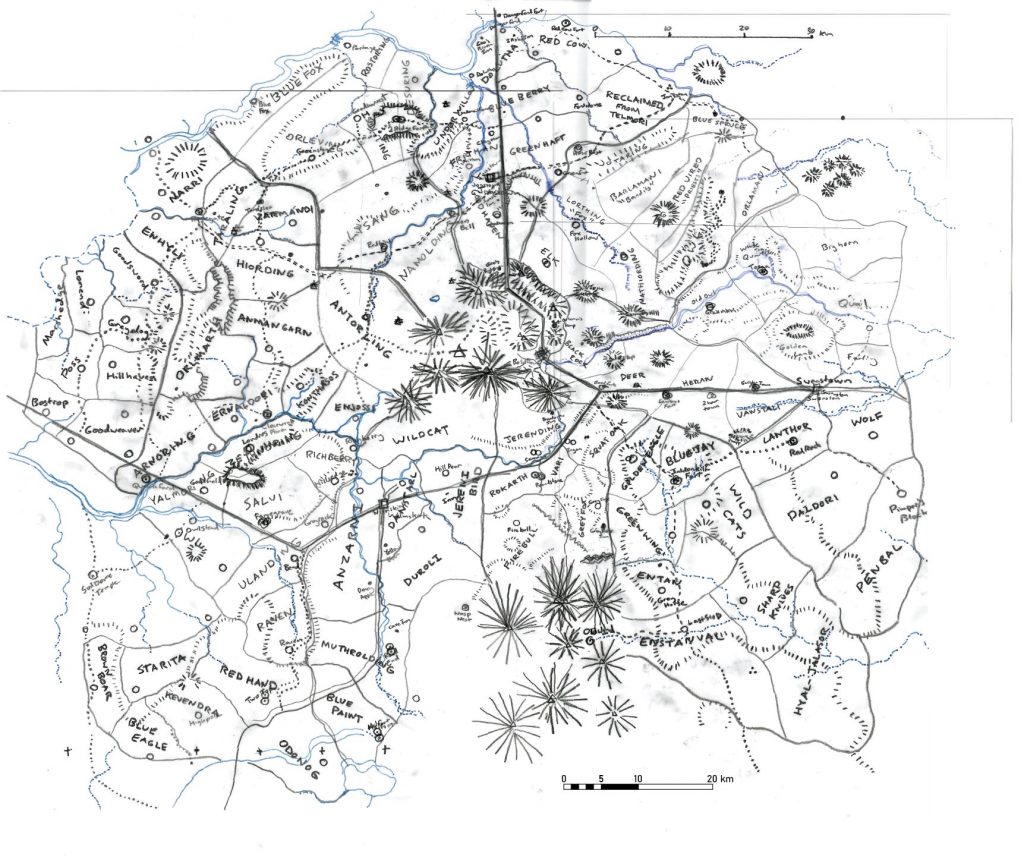
Having a big event like that in a game could be a big deal: besides the cool “Woodstock” or “Burning Man” vibe of a whole bunch of people camping together, this is a good opportunity to meet new NPCs, forge new ties, engage in gossip, and more…
Thousands of people, sometimes tens of thousands, would attend these rites. Priests and temples would jostle for priority, but for generations the Hill was under the direct protection of Hofstaring Treeleaper, a close ally to the Sartar Dynasty, and appeal to the Prince was thus rare.
There were of course many lesser celebrations of Sacred Time in Sartar, but the sacrifices at the Hill of Orlanth Victorious was THE celebration. The Prince, his household and companions, the leaders of the Lightbringers cults – all attended.
If you want a visual reference for the hill, Jeff suggests Bear Butte, in South Dakota:
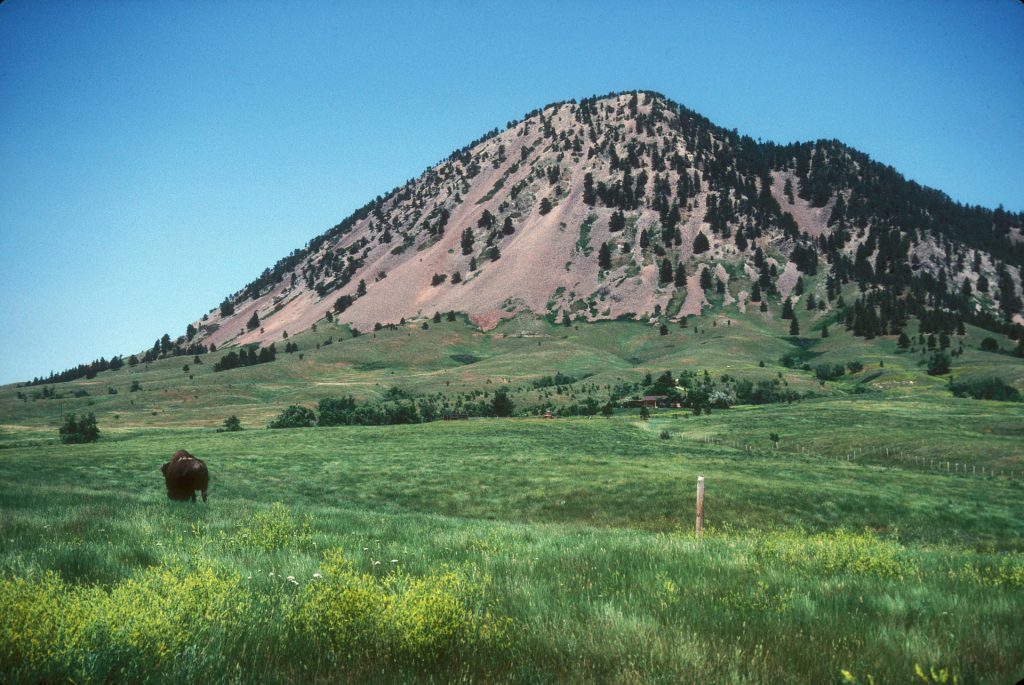
After Starbrow’s Rebellion, the Hill was guarded by the Yelmalio Cult (instead of by Lunar soldiers), and the celebrations were much smaller (and notorious rebels were turned away from the hill). With the Liberation of Sartar in 1625, arranging the Sacred Time rites at the Hill of Orlanth Victorious were viewed by many to be the single most important and pressing priority of the new Prince.
Jeff notes that the Yelmalions guarding the Hill is “a direct repetition from the Greater Darkness“… that’s nice of them, although getting paid by the Lunars is not quite the same.
Don’t forget that the Hill of Orlanth Victorious is classified, in game terms, as a Great Temple, so there is bound to be a lot of associated cult activity, too, from sages and merchants to clowns and berserkers…
All the tribes of Sartar would be present, one way or another, temporarily setting aside any rivalry. However:
Of course some tribes are overrepresented – the Culbrea, the Cinsina, the Kheldon, not to mention the urban populations of Boldhome and Jonstown. And other tribes are underrepresented – the Ducks, Lismelder, Locaem, and Kultain are present in only small numbers if at all.
As the place from which Orlanth began his Lightbringer’s quest, and where Harmast Barefoot began two heroquests of that myth, the Hill of Orlanth Victorious has a pretty “permeable” boundary between the mundane world and the Other World:
Steps are taken to make sure the participants do not begin the Lightbringers Quest (as that quest is known to be extremely dangerous and unpredictable). For example, the Bad Rain is not normally summoned and the full ring not gathered.
But after the Liberation of Sartar, Prince Kallyr Starbrow begins preparations to perform the Lightbringers Quest (although she makes preparations to limit its dangers and unpredictability). Her quest, ultimately a failure, accelerates the Hero Wars and dissuades any from following in her footsteps for another generation, when Prince Argrath, desperate in the face of renewed Lunar might, performs the quest without any limitations or reservations.
Holy Places of Dragon Pass
Speaking of holy places where the boundary between worlds is thinner, Jeff gives a list of the notables ones: Hill of Orlanth Victorious (as we just saw), Kero Fin, Shake Land (which I assume is the area around the Shaker Temple?), Wild Temple, Quivin Peak, Dragons Eye, Caves of Chaos, Castle of Lead, Tarndisi’s Grove, Dryad Woods and Forest of Wondrous Beasts, and Arrowmound Peak.
I’m actually surprised to see Tarndisi’s Grove there: I assumed this one one of several elf groves around Dragon Pass, and not something special enough to make that kind of list. Or maybe all elf groves would make that list?
Many of these places have been centers of cult activity for centuries or even millennia. When you see them, you know that this is something wondrous and remarkable. Mortals gather at these places to interact with the Godtime, and spirits and gods can be easily contacted there.
Such magical locations have power comparable or greater than the greatest temples, even without the presence of the mortal worshipers. They are were great acts of Creation took place, where the world took its present form, or linger remnants of a world that otherwise died in the Great Darkness, or both.
What About the Triolini?
Jeff thinks that the Triolini don’t get enough attention in games centered around Dragon Pass, the Lunar Empire, or Prax… and I mean… yeah? There’s so much to do inland that adventurers probably don’t go down south to the shore very often.
It is worth considering that there are some 33,000 triolini in the Choralinthor Bay, mainly ludoch merfolk, but a smattering of mightier beings.
Fatalistic and often harshly practical, the ludoch are about as interested in landwalker politics as humans are in the conflicts beneath the sea. Their gods are often similarly ignored by the landbound species, but within their watery domain they are supreme.
I’ve always found the non-human pantheons overly simplistic, which can easily be explained out of game (people play humans the vast majority of the time, and therefore need more material there) and in-game (the God Learners who classified these deities are humanist elitist assholes… and I say that with much fondness in my heart). I think if I had a game that took a closer look at the merfolk, I would hint at little-known gods and heroes…
Until a little more than 40 years ago, the surface of the oceans were impassable to the landbound. Prior to that only the triolini had access to the blue waters. With the Opening of the Seas, the Mirrorsea ludoch are a tremendous ally for the sailors of Kethaela. They know (or can easily learn) the currents, conditions, and dangers of each body of water and can often intercede with the rulers of the waters on behalf of their friends.
One day I’ll get to play this long-distance trading campaign I’ve had in mind since I started reading about Glorantha. I think alliances and safe passage with the Triolini would feature just as much, and maybe more, as alliances and safe passage with various tribes, trolls, and other factions on land.
The Crimson Bat, and Other Terrors
Jeff mentions that, just like in Call of Cthulhu, the world of Glorantha is populated by horrible giant monsters: the Crimson Bat, Cwim, the Mother of Monsters, the Chaos Gaggle, the True Dragons, etc. The difference, Jeff posits, is that there are also heroes that are capable of defeating them, hinting that he has for instance seen games where Argrath defeats the Crimson Bat.
As a long time Call of Cthulhu player, I would add that the Mythos creatures have a few other things Gloranthan Terrors don’t have:
- A tendency to be a lot more “weirdly supernatural” (such as those who stalk you across time and manifest through acute angles, or those who are hyperdimensional beings who only appear as a color that can’t possibly perceive)
- An ability to blast your sanity way more effectively (Terrors have spot “fear” rules that arguably make these monsters more personalized and flavourful, but few have that kind of power, and their effects are never permanent)
- The ways to destroy them consistently involve corrupting yourself with their nature (I don’t think I’ve heard about anybody who had to take on a Chaos Taint to defeat a Terror, but that’s a great lead for an adventure if you ask me…)
Anyway:
But the presence of things like the Crimson Bat, as well the Lunar College of Magic, the Crater Makers, Jar-eel, the Full Moon Corps. etc – these are the backbone of the Lunar Empire’s incredible successes. The regular army units are better than average, but not powerful enough to defeat Sartar led by a member of its royal dynasty. But with its magicians, the Lunar Army can roll over most foes.
Unless of course they have their own magicians and heroes….
Jeff continues:
The importance of the Crimson Bat for the expansion of the Lunar Empire cannot be understated. We all know it is awesomely powerful in its own right, able to devour an entire regiment, spirits, and more – but it is also a Glowspot. Within about 10 miles of the Crimson Bat, Lunar magicians suffer no penalties even on crescent and dark Lunar phases.
The pinkish glow of the Crimson Bat can be seen for many miles, and its presence in the borderlands of the Lunar Empire strikes terror into the hearts of outsiders. One can assume if the Crimson Bat is heading your way it is accompanied by soldiers, magicians, and more.
During The Strong Making Peace wane, the Lunars used the Crimson Bat and Yara Aranis to strike fear into those nomads not led by Sheng Seleris – even those two demons were insufficient to strike against Sheng Seleris directly. But against tribal uprisings or confederations, they are normally more than sufficient.
I imagine there must be a big difference between a citizen’s view of the Empire, and that of a foreigner. The citizen’s view is about living in or near a city with art and culture and wealth and an idealized image of the Red Goddess and the upper class. People at the edge or outside of the empire see it as a ruthless imperialist machine with weapons of mass destruction, a highly corrupt and potentially insane ruling class, and a tendency to create their own enemies. Any similarity with a real-world nation would be coincidental…
That’s why I find it interesting to explore the difference between Passions like Hate, Devotion, and Loyalty to the Red Emperor vs the Red Goddess vs the Lunar Empire vs a specific nation like Tarsh.
About the Glowline
Speaking of the Lunar Empire, Jeff talked a bit more about the Glowline (and I did too in a recent blog post on its game mechanics):
Normally, Lunar Rune magic and Lunar magical techniques are only at full effectiveness three days out of the week. The other four days a week, Lunar magic is either underpowered or not available at all.
During the wars of the Zero, First, and Second Wanes, this was not that great of a disadvantage. Few of the Empire’s foes really understood the Lunar Cycle, and the Lunar magicians were a minority within the army. Most soldiers belonged to non-Lunar cults – Lodril, Yelm, Humakt, whatever – and were usually just lay members of the Seven Mothers. Lunar commanders would maneuever [sic] so that battle would occur on Empty or Full Half days, or even better during the Full Moon, so that the Lunar magicians could play a decisive role in the battle.
As the Lunar religion grew, more and more soldiers were members of Lunar cults, and the Lunar magicians grew in importance.
Jeff then explains that the Third Wane was a disaster, since Sheng Seleris figured out that he could outmaneuver the Lunars and force them to fight on waning days. This was especially easy since Sheng’s army was entirely composed of highly mobile horse-riding nomads.
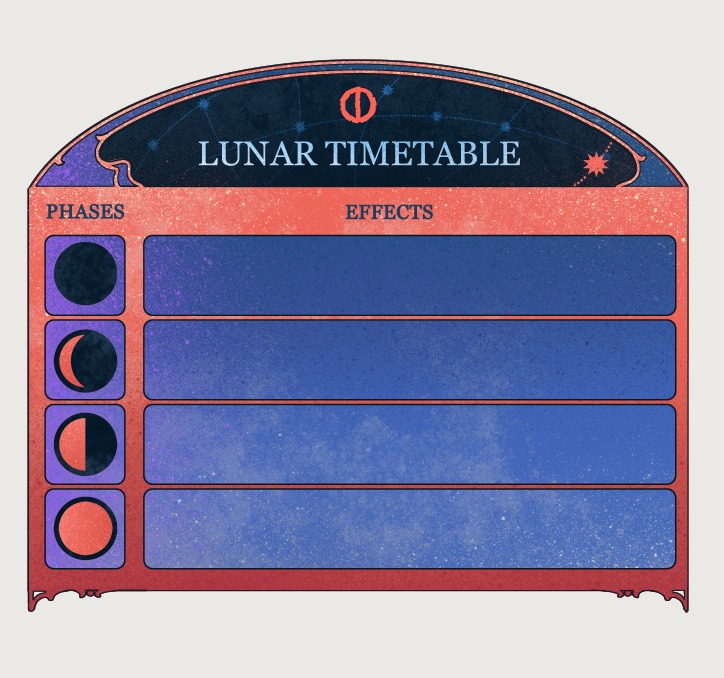
Yara Aranis was created to resolve this weakness. Her temples provided centers for magical defense, and the Glowline which they created eliminated the weakness of Dark and Crescent Moon days. Within the Glowline, it is always effectively Half Moon day. Lunar magic is fully effective, and the superior resources and training of the Lunar magicians mean that they are usually a match for any comparable number of opposing magicians. And since the Lunar empire has not foe capable of mustering a comparable number of opposing magicians, this means that within the Glowline there is almost no foe that can stand against the Lunar College of Magic.
Outside of the Glowline is another story. Four days out of the weak, the decisive arm of Lunar victory is denied to the Lunar Army. The Lunar Army tends to be tentative, hesitant, and easily routed outside of the Glowline, unless led by the Red Emperor, accompanied by the Crimson Bat, or led by a first tier leader like Fazzur Wideread.
If you’re wondering why Yana Aranis didn’t make the Glowline permanently “full moon” (which I looked at in my article from a purely game design perspective), Jeff gives a more in-world reply:
[It is] outside of her power. Can’t get something for nothing, not even for the Red Goddess.
And if you’re wondering why an expansionist empire would make costly stationary temples to support their magic, instead of an entire fleet of mobile Glowspots units, Jeff also has an explanation for you:
When they created the Glowline they were definitely NOT an imperialistic expansionist culture. They were a barely holding on, trying to survive being conquered by a World Conquerer.
Heroquesting Lunar Myths
While we are with the Lunars, here are some notes about heroquesting their myths:
Few non-Lunars have ever dared explore the experimental landscape of Lunar mythology. Most celestial cults are reluctant to look into the shadows, and the Earth cults rarely look up into the sky. Maybe some of those Water cults might take a back route there along the path of the Blue Moon, but who cares about merfolk!
This is generally interesting, and somewhat validates some hook I used recently in my game: elves were reluctant to heroquest into Darkness deities’ stories, and got the adventurers to do that for them… well, my players ended up refusing to go down in that pitch black hole so I guess it didn’t work, but fun times anyway.
So who might be bold enough to explore Lunar mythology? Jeff has two candidates in mind:
The more intrepid Darkness cults like Subere are comfortable in the deepest darkness of the Underworld and might be able to find some of those same paths. Heck, might know some of them better than She does. So if I were the Red Emperor I’d be cautiously wary of the trolls as much as I despise them as vile digijelm.
The other candidate would be a god famed for assembling a band of misfits and then forging a path through the deepest Underworld to its very bottom. One who was willing to get lost, to lose everything, in order to find the right path through the deepest darkness of the Underworld and then unite others to defeat the God of Chaos. One whose defining Quest is so very similar to that of the Red Goddess herself that it might be that his quest be uncomfortably near the source of Her power? Yes, I would keep on eye on that one as well.
To me however the question isn’t so much “who would dare heroquest into Lunar myths” but “what would they do with it”! Got any good scenario hooks? Please share them!
Karse
Let’s bounce down to the other side of Dragon Pass, to the city of Karse. It’s in Hendrikiland, south-east of Sartar, on the shore of the Mirrorsea Bay. Jeff notes that it’s very old, as it dates back to the Dawn.
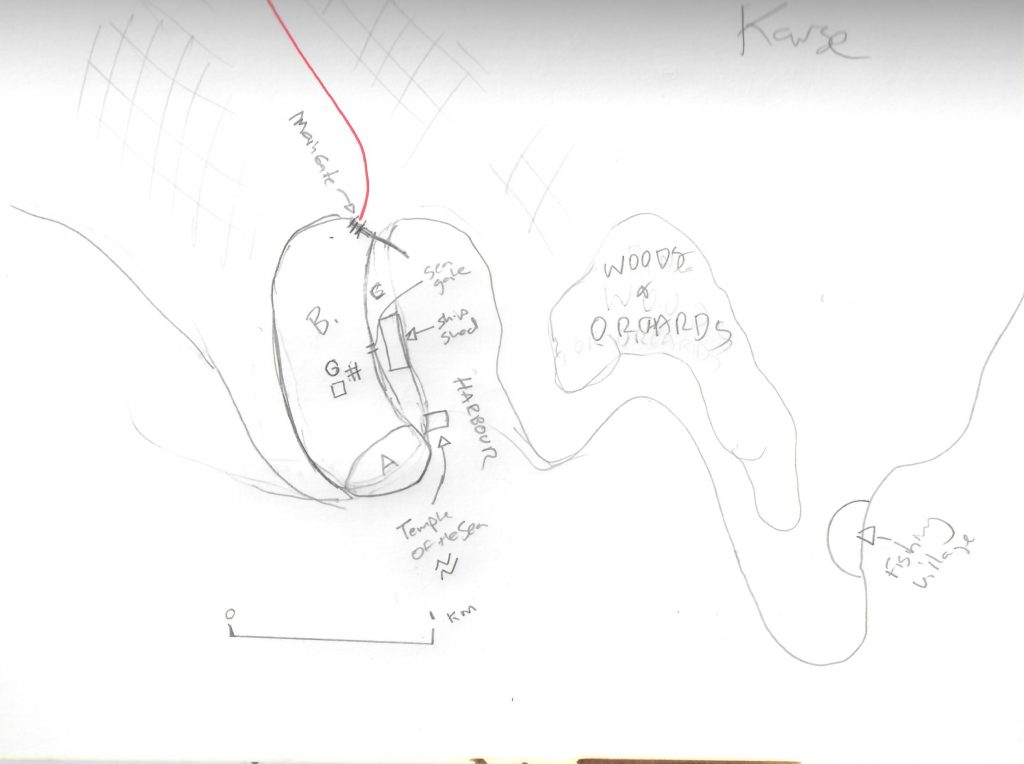
Karse has a fortifications all around, with two main gates – a Land Gate (the main gate) and a Sea Gate (that leads to the harbour).
A. Fortress. This fortress guards the harbor. It fell to an assault of dragonewts in 1619. It is now the base of operations of whoever rules the city.
B. Main City. Here are the temples, residences, markets, and warehouses. The enclosed area probably has several open areas, for tanning, and other crafts, or for storage of bulk goods or animals. I imagine there are a lot of inns – caravanserai – in the city.
C. The Beach. This is where boats are beached. There’s a ship shed for repair, maintenance, etc., that probably can house 20 ships. There’s a wall near the end of the harbor, past that small fishing boats are beached. Also on the Beach is the Sea Temple, with shrines to Magasta, Choralinthor, Diros, Dormal, and the gang.The Harbor is a natural inlet that has been worked on for the last 1500 years.
Beyond the harbor are coastal pine woods and orchards, and a large fishing village.
Jeff provides a little bit more information in follow-up comments: elements of the cyclopean walls from before the Greater Darkness are probably still used, “but those are thousands of years old, and likely much has been replaced“.
This should be enough to flesh out the city for a campaign!
Jeff also recommends looking at Massalia as an Earth analog for Karse. Massalia is the ancient name for the contemporary city of Marseille, in Southern France. It was founded as a Greek colony around 600 BCE, and might have looked like this during its Hellenistic heyday:
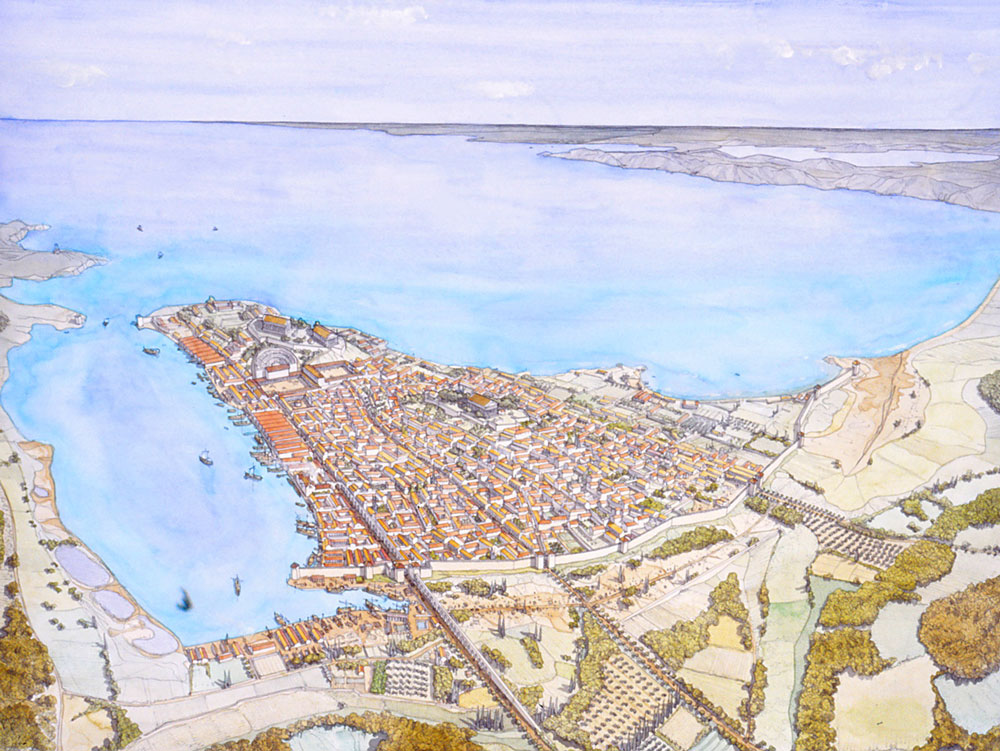
Notice the roughly rectangular harbour, with the city on the left side (when sailing in) in both Karse and Massalia. With this harbour, Karse is a notable trade city, so it is “going to have lots of inns and caravanserai as it is an entrepôt for the trade through Dragon Pass to Peloria and Prax“.
The city is no doubt filled with Sartarites and Esrolians, perhaps more than Heortlanders. There are likely some Etyries merchants still there, as they are protected by the Issaries cult, but I suspect most of the Seven Mothers cultists fled in 1624.
Jeff notes that in the early 1600s, Etyries merchants and Seven Mothers cultists would have been present too. Sure, they could report back on any war effort related to the Lunar invasion of Sartar, but so would Issaries merchants going to Peloria. There’s a lot of trade anywhere from Karse to Furthest.
“Few Gloranthans believe in total war – certainly not the central Genertelans“, says Jeff, so all leaders across Dragon Pass prefer to keep the very lucrative tolls and taxes coming from trading rather than close their borders when a war is going on. In particular, the King’s Roads in Sartar are under the direct protection of the Prince of Sartar, whose main deity (Orlanth) is neutral towards the Etyries cult anyway.
Martin Helsdon added a bit of historical context if you have trouble reconciling war and trade going on in parallel. As often, I see these situations as opportunities for more fun and adventure. The adventurers might escort a caravan and be approached by spies of one faction or other, asking to carry secret messages, spy on their employer, or whatever else. They might find a route temporarily closed for a reason or other, and have to bribe their way through, or find a detour. They might even be framed, as a patrol searching their stuff finds something they shouldn’t have!
Community Roundup
The community roundup is our highlight of interesting things being mentioned in the Glorantha-related Facebook groups, sub-Reddits, and other similar online places.
Crawling Through the Rainbow Mounds
You might know the map by heart if you’ve played the Rainbow Mounds from its classic incarnation to its RuneQuest Starter Set revamp… but do you know how claustrophobic it feels when you’re actually inside? Fear not! Err… well, actually no, do fear!
D R is working on building the entire cave complex in Unreal Engine (a quite fine choice of game engine if I say so… ahem). Check it out:
According to some status update on the BRP forums, the modelling is done, but there’s still work to be done on the textures.
The Iconic Podcast Reviews the Starter Set
JM and Evan delve into the RuneQuest Starter Set for almost an hour, with the most in-depth review to date of this product.
A Cool Looking Wood Lord
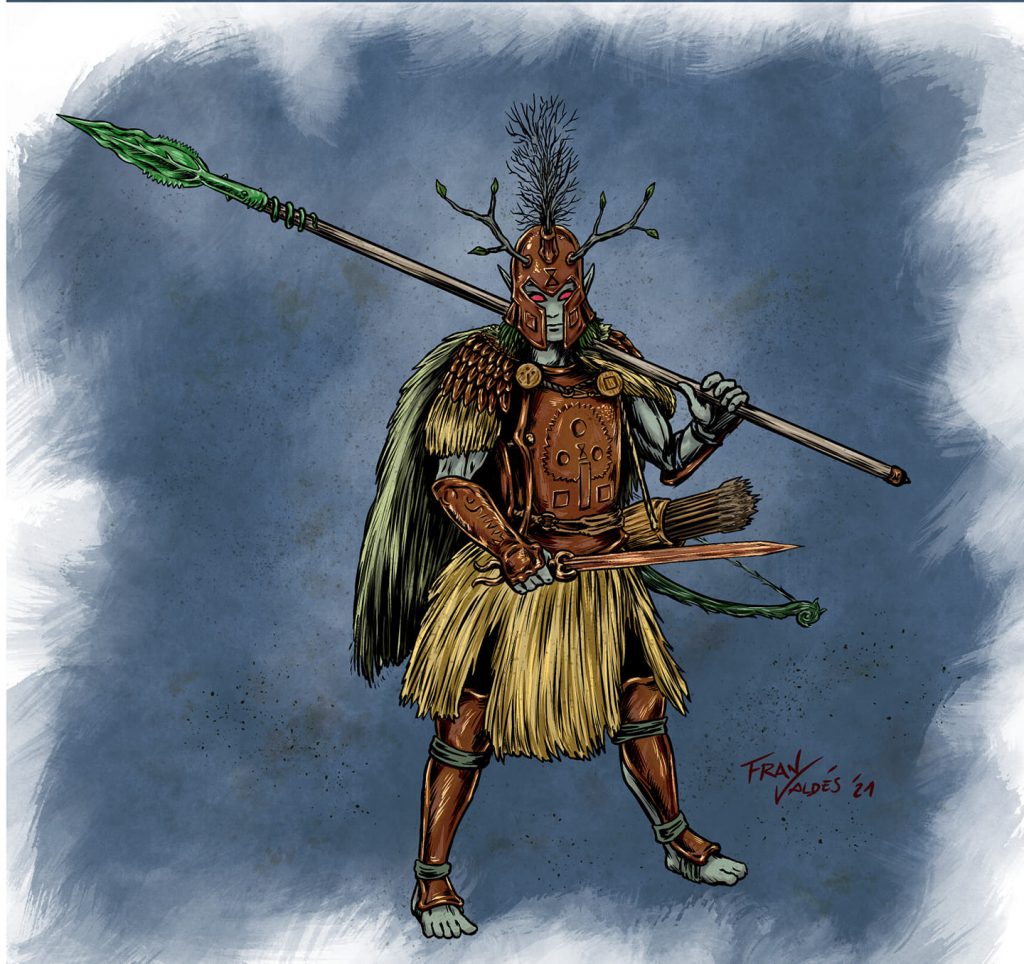
Fran Valdes painted this nice looking Aldryami warrior!
Aldriami vronkali, Wood Lord in arms. Runic cooper plate armor and sword. Spear head hasvested from a magic plant. Hail Aldria!!!
Elsewhere on Arachne Solara’s Web
Not everything is about Glorantha, although most things are! Here are loosely relevant things that we found on the interwebs.
Real-Life Dryad
I’ve seen this image popping up a lot in my feeds this week! Hard to say if it’s an image manipulation, or if the tree has been “nudged” into shape, or if it’s a totally natural occurrence, but it sure is a great art reference for a dryad:

Another nice one is the “dragon tree” in North Carolina:
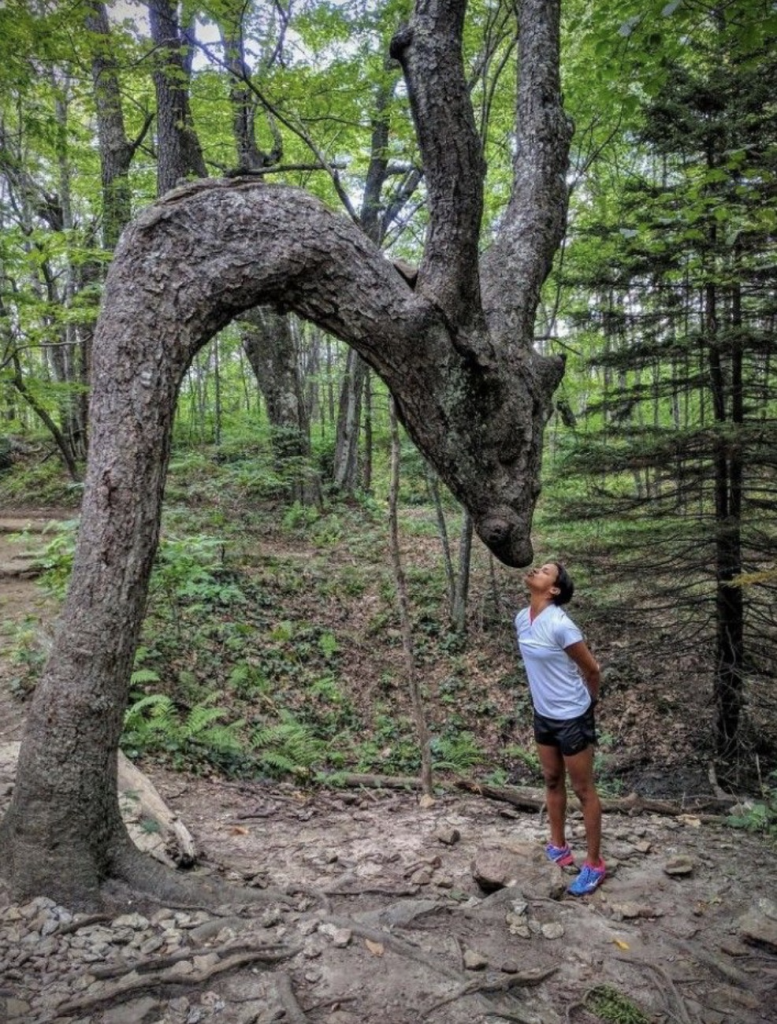
Thank you for reading
That’s it for this week! Please contact us with any feedback, question, or news item we’ve missed!



3 comments on “Journal of Runic Studies #27”